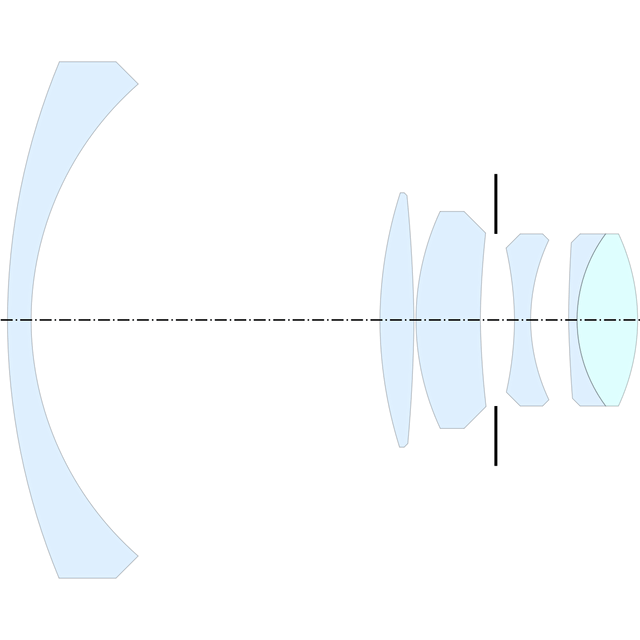Angénieux retrofocus

Angénieux retrofocus

| Introduced in | 1950 (stills) |
|---|---|
| Author | Pierre Angénieux (1950) |
| Construction | 6 elements in 5 groups |
| Aperture | f/2.5 |
The Angénieux retrofocus photographic lens is a wide-angle lens design that uses an inverted telephoto configuration. The popularity of this lens design made the name retrofocus synonymous with this type of lens. The Angénieux retrofocus for still cameras was introduced in France in 1950 by Pierre Angénieux.
| Introduced in | 1950 (stills) |
|---|---|
| Author | Pierre Angénieux (1950) |
| Construction | 6 elements in 5 groups |
| Aperture | f/2.5 |
Inverted telephoto concept
The telephoto lens configuration combines positive and negative lens groups with the positive at the front, so as to reduce the back focal distance of the lens (the distance between the back of the lens and the image plane) to a figure shorter than the focal length. This is for practical, not for optical reasons, but rather because telephoto lenses can then be made shorter and less cumbersome.
The inverted telephoto configuration does the reverse, employing one or more negative lens groups at the front to increase the back focal distance of the lens – possibly to a figure greater than the focal length – in order to allow for additional optical or mechanical parts to fit behind the lens.
The inverted telephoto design was first employed in the 1930s by Taylor-Hobson for the early Technicolor "3-strip" cameras since the beam splitter unit behind the lens required significant space, so that a long back focal distance was essential.[3] Horace Lee patented an inverted telephoto lens design in 1930 with an angle of view of 50° and maximum aperture of f/2 which afforded a distance between the rear element and the film plane approximately 10% greater than the focal length.[1][2] Joseph Ball showed how a beam-splitting apparatus could be fitted in the space gained.[4] Also, wide-angle lenses for narrow-gauge movie cameras had to be of this type because of the shutter mechanism that had to fit in between.
In still photography, a single-lens reflex camera requires a space for the reflex mirror, imposing a limit on the use of wide-angle lenses of symmetric designs. The retrofocus lens addressed this situation by increasing the distance between the rear element and the focal plane, thus making wider-angle lenses usable while retaining normal viewing and focusing. Unless the reflex mirror were locked in the "up" position, blacking out the viewfinder, the rearmost element(s) of a non-retrofocus (symmetric wide-angle) lens would interfere with the movement of the mirror as it flipped up and down during exposure.
Implementation
Pierre Angénieux applied for a patent in 1950. In the original patent, he presented two lenses with an angle of view of 65°, approximately equal to the view of a f=35mm lens on the 35mm format for still cameras; the first example had a maximum aperture of f/2.5, while the second example had a maximum aperture of f/2.2.[5]
At approximately the same time, Harry Zöllner and Rudolf Solisch applied for a similar patent on an inverted telephoto lens design, branded Flektogon, for Carl Zeiss Jena.[6][7] Carl Zeiss Oberkochen also created an inverted telephoto design branded Distagon (5.6/60mm) for the Hasselblad 1000F in 1952.[3]
Made in focal lengths of 24 mm, 28 mm, and 35 mm, the Angénieux retrofocus lens inspired other lens makers to produce wide-angle lenses of this type for almost every 35mm SLR, and helped to make it the definitive camera type of the late 20th century.
